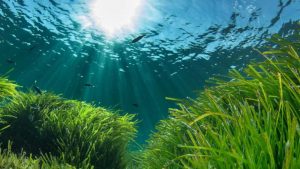 ©FUNDACIÓN AQUAE
©FUNDACIÓN AQUAE
La posidonia oceánica es una especie endémica y exclusiva del mar Mediterráneo. Las praderas de posidonia se pueden encontrar en la zona superficial del mar hasta los 30-40 metros de profundidad, dependiendo de la transparencia de las aguas. Esta especie ocupa una gran extensión del litoral mediterráneo.
A diferencia de las algas, la posidonia tiene hojas, tallo y raíces y también produce flores y frutos. Las algas crecen en fondos duros o rocosos, mientras que la posidonia mediterránea lo hace sobre fondos móviles o arenosos.
Esta planta es clave en la dinámica sedimentaria porque mantiene el sedimento inmóvil con sus raíces, creando zonas de oxígeno, cría y refugio para muchas especies de animales. Se estima que más de 400 especies vegetales y 1000 animales habitan en las praderas de posidonia. Además, funcionan como filtradoras, ya que limpian el agua, manteniéndola siempre transparente.
Una de las características más curiosas de esta planta es que, al fijarse en el sustrato, tiene la capacidad de extenderse varios kilómetros, produciendo millones de plantas a partir de un mismo clon. Existen ejemplares de posidonia separados de la misma planta a más de 15 kilómetros. Además, se trata del ser vivo más longevo de este planeta, ya que los científicos estiman que presenta una edad de 100.000 años.
La posidonia, como muchas otras especies de seres vivos, se encuentra en peligro. Su principal amenaza es el alga Caulerpa, que se introdujo en el Mediterráneo de manera accidental por el hombre debido a un vertido en un acuario de Mónaco. Este vertido no sólo invade la zona de las praderas de posidonia, sino que desestabiliza todo un ecosistema animal y vegetal debido a un sensible descenso de la biodiversidad. Las toxinas que presenta esta alga invasora no son comestibles para la microfauna, por lo que carece de enemigos naturales. La única manera de evitar su expansión es arrancarla.
Por otro lado, al ser una especie que crece a poca profundidad, el fondeo de las embarcaciones puede afectar negativamente a su estabilidad. Además, es una de las especies más sensibles a la contaminación, por lo que las aguas que la rodean deben encontrarse siempre muy limpias.
Esta planta resulta esencial para comprender y conocer el medio marino mediterráneo, por lo que está catalogada por el CITES e incluida en el Listado de Especies Silvestres en Régimen de Protección Especial en el Mediterráneo.
__
THE MEDITERRANEAN OCEANIC POSIDONIA
Posidonia oceanica is an endemic and exclusive species of the Mediterranean Sea. Posidonia meadows can be found in the superficial zone of the sea up to 30-40 meters deep, depending on the transparency of the water. This species occupies a large area of the Mediterranean coast.
Unlike algae, posidonia has leaves, stems and roots and also produces flowers and fruits. Seaweed grows on hard or rocky bottoms, while Mediterranean Posidonia grows on mobile or sandy bottoms.
This plant is key to sediment dynamics because it holds the sediment immobile with its roots, creating oxygen, breeding and refuge areas for many species of animals. It is estimated that more than 400 plant species and 1000 animals inhabit posidonia meadows. In addition, they function as filtering plants, as they clean the water, keeping it always transparent.
One of the most curious characteristics of this plant is that, by attaching itself to the substrate, it has the capacity to spread several kilometers, producing millions of plants from the same clone. There are specimens of Posidonia separated from the same plant by more than 15 kilometers. In addition, it is the longest living being on this planet, as scientists estimate that it has an age of 100,000 years.
Posidonia, like many other species of living beings, is endangered. Its main threat is the Caulerpa algae, which was accidentally introduced into the Mediterranean by man due to a spill in an aquarium in Monaco. This spill not only invades the area of posidonia meadows, but also destabilizes an entire animal and plant ecosystem due to a significant decrease in biodiversity. The toxins presented by this invasive algae are not edible for the microfauna, so it lacks natural enemies. The only way to prevent its expansion is to uproot it.
On the other hand, being a species that grows at shallow depths, the anchoring of boats can negatively affect its stability. It is also one of the most sensitive species to pollution, so the waters around it must always be very clean.
This plant is essential to understand and know the Mediterranean marine environment, so it is listed by CITES and included in the List of Wild Species under Special Protection Regime in the Mediterranean.
__

